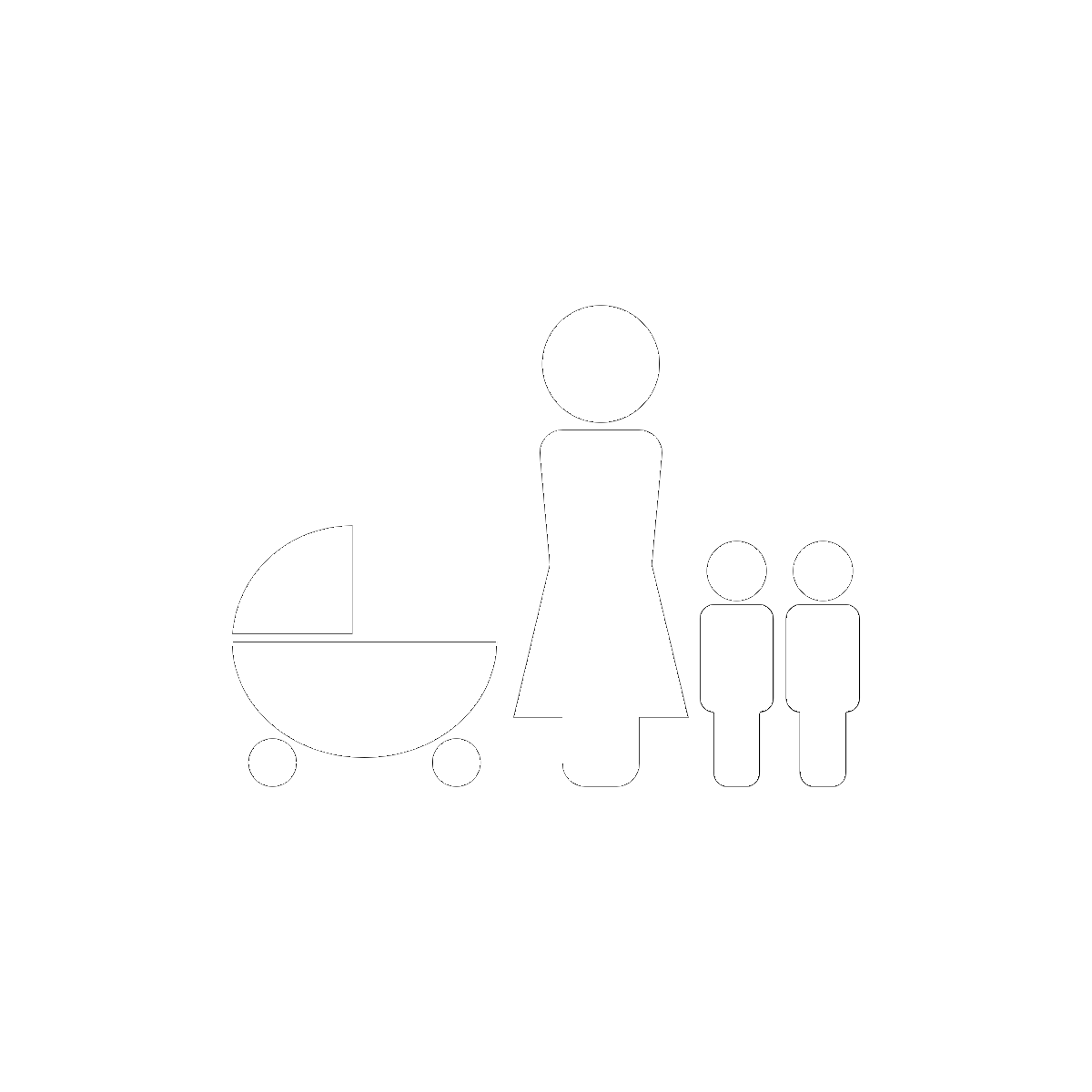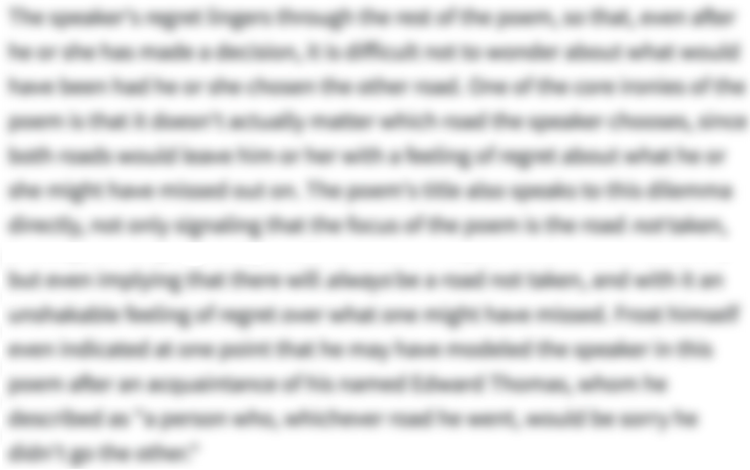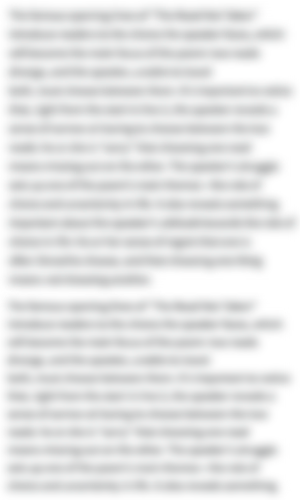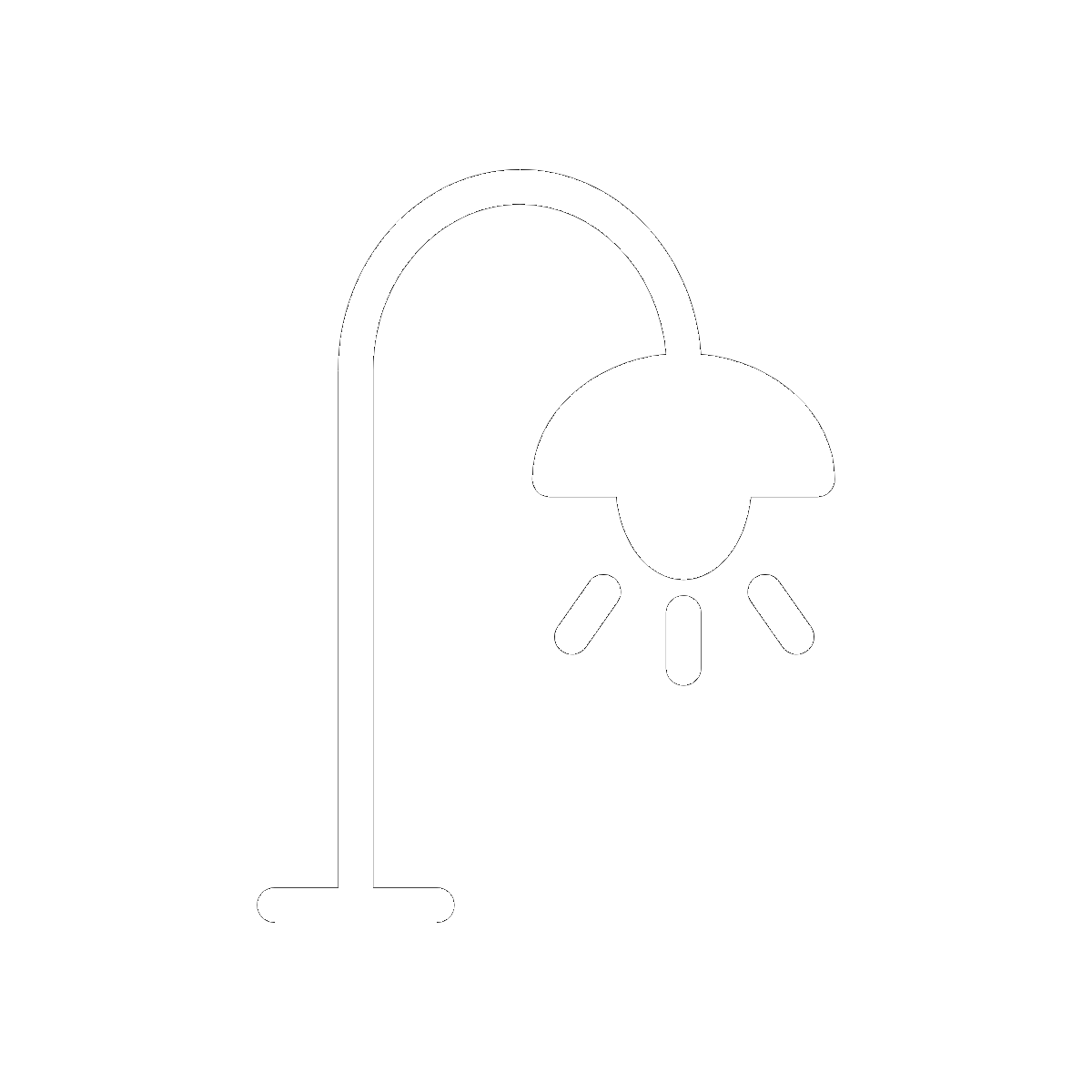-
“In The Park” Introduction
-
Gwen Harwood’s “In the Park” was first published in 1961 under a male pseudonym—and no wonder: its grim but unflinching view of motherhood as a source of regret and resentment was radical for its time. When the author was revealed to be a woman, many were shocked. However, the poem has been widely taught and anthologized since, and is celebrated today for its achievement in upending conventional beliefs about motherhood and keenly capturing the complex reality of women’s maternal experiences.
-
-
“In The Park” Summary
-
The speaker describes a woman sitting in a park, wearing clothes that are out of style. Two of the woman's children are complaining and arguing next to her, and pulling annoyingly on her skirt. Her third child is drawing random designs in the dirt. A former lover passes by.
The woman realizes it's too late to pretend not to recognize the man when he casually nods hello. "How nice to see you," he says, among other expected pleasantries like "what a surprise" and "how time has passed!" The man's actual thoughts seem obvious to the woman, rising up from his well-groomed head like a balloon: "Thank God this isn't my life," the mother can tell he's thinking.
The two stand chatting a while in the dimming park light, the woman sharing the children's names and birthdays like she always does. "It's so fulfilling to hear their little voices, to watch them grow up and do so well," she says as the man walks away with a smile. Once he has gone, the mother nurses the baby, and sits staring blankly at her feet. To the wind, she confesses, "My children have consumed my entire life."
-
-
“In The Park” Themes
-

Motherhood and Identity
“In the Park” is concerned with the smothering nature of motherhood and its effect on women’s identity. The poem suggests that motherhood, something that’s usually idealized, is in fact a far more disappointing and difficult endeavor than society or even women themselves acknowledge. The poem goes so far as to imply that to be a mother is to lose one’s identity altogether. This deeply unconventional stance undermines centuries of societal beliefs about motherhood by portraying it as a source of regret, depression, and resentment.
The poem opens with a woman sitting in the park with her three children. From the start, it pulls no punches when it comes to depicting motherhood as a disheartening undertaking. The children “whine and bicker,” or draw “aimless patterns in the dirt.” The light in the park “flicker[s]” ominously, and the mother “stare[s] at her feet” blankly while she nurses her baby. Every well-chosen word precisely captures the tedium, resentment, and depression experienced by this mother of three.
In addition to describing the hardships of motherhood, the poem takes pains to paint the woman’s image and identity as irrevocably impacted by her children. Her clothes are now “out of date.” In the fourth line, “Someone she loved once passe[s] by,” and they strike up a conversation—but only by happenstance, suggesting that the woman’s social circle has shrunk since becoming a mother. However, the poem also implies (“too late / to feign indifference”) that she would rather not have had her ex-lover see her in this new role and identity.
And no wonder! Over the course of their conversation, the poem suggests that women lose their sense of self, both in their own eyes and in the eyes of others, once they become mothers. The half-quoted proverb, “but for the grace of God,” suggests that despite his former affection for her, the man now views this woman as nothing more than a dreary housewife and mother—a type of person he is grateful not to be associated with. He “depart[s]” even while she is still speaking to him.
At the same time, the woman, despite clearly finding motherhood to be a smothering experience, nevertheless feels obligated to perform the identity of a good mother. She “rehears[es] / the children’s names and birthdays” and expresses platitudes about watching them grow.
As soon as her audience is gone, however, the woman confesses otherwise. “They have eaten me alive,” she says, “to the wind,” the poem’s most explicit and ruthless assessment of motherhood, indicating that the woman resents her circumstances. That she utters these words while “nursing / the youngest child” makes painfully clear that the woman’s identity has indeed been entirely subsumed by her role as mother.
Where this theme appears in the poem:- Lines 1-14
-

Social Expectations vs. Reality
At the heart of “In the Park” lies the sharp contrast between the ideal of motherhood and its lived reality. The poem not only highlights the struggles of motherhood, but also suggests that this struggle is made all the harder by the fact that society doesn’t acknowledge these struggles. As the poem captures in a conversation between a mother and her ex-lover, it is socially unacceptable for mothers to talk about their challenges. This social pressure both erases and compounds motherhood’s hardships, the poem implies, perpetuating a rosy, false narrative that naturally leads to disappointment when women encounter the reality of what motherhood is actually like.
The poem opens by clearly establishing motherhood’s difficulties and frustrations: children “whine and bicker” and “tug [on their mother’s] skirt.” It then swiftly moves on to exposing the gulf between society’s idealization of motherhood and its actual treatment of mothers. A former lover passes through the park and stops to chat with the woman at the center of the poem.
Their conversation is full of surface-level pleasantries, but hints at deeper, darker sentiments that neither are willing to say out loud. For instance, the man’s use of clichés (in phrases like “Time holds great surprises” and “but for the grace of God”) indicates a clear lack of desire to go deeper or truly understand this woman’s new life as a mother. The poem sharply juxtaposes verbs such as “feign” and “rehearse” with the mother’s statement that “[i]t’s so sweet / to hear their chatter, watch them grow,” illuminating the gap between what she believes society expects her to say about her role and how she actually feels.
What’s more, the poem indicates that the woman herself is keenly aware of this gap. The fact that she wishes she could have “feign[ed] indifference” to her passing ex-lover’s “casual nod” suggests that she knows she cannot be honest with him, and so wishes she could have avoided engaging in this hollow conversation at all. She is well-aware of how her ex-lover views her now that she is a mother; she imagines she can see his disdain “ris[ing like] a small balloon” from his head. Nevertheless, she does her best to meet social expectations, “rehearsing the children’s names and birthdays” like a good mother should.
In doing so, the woman ends up perpetuating the same narrative about motherhood that she herself was almost certainly brought up with and which has clearly led to major disappointment and bitterness. Unsurprisingly, her dishonest conversation leaves her feeling emptier than ever, “staring at her feet” after the man has gone while she nurses her baby. As soon he has left, she confesses, but only “to the wind,” that her children “have eaten [her] alive.”
The fact that this woman only feels safe being honest “to the wind” furthers illuminates the damaging effects of social expectations. Society’s idealized view of motherhood has kept her from confiding in someone about the reality, someone who could potentially offer support. However, though the woman does not admit to the man she used to love how much she resents her new role and life, she is nevertheless brave enough to admit it to herself—and to readers.
Indeed, though the poem takes a grim view of both motherhood and society, its unflinching honesty about the struggle of motherhood is remarkable. By decrying the fact that women are expected to sacrifice themselves on the altar of motherhood, it stands out as a deeply radical work of art, and one in keeping with the feminist movement of the time in which it was published.
Where this theme appears in the poem:- Lines 1-14
-
-
Line-by-Line Explanation & Analysis of “In The Park”
-
Line 1
She sits in ... out of date.
"In the Park" opens by introducing its main character: an unnamed woman who "sits in the park" wearing "out of date" clothes. From the start, the poem uses a number of different poetic devices, particularly those emphasizing sound, in order to clue readers in about the woman's unhappy situation.
Perhaps most importantly, a caesura splits the line into two separate sentences and immediately disrupts any potential for regular rhythm. This is an example of parataxis, which combines with the lines' short syllables to create a feeling of abruptness, a distinct lack of musicality. The poem does not allow readers to settle in, but instead keeps them on edge.
These two sentences are also full of assonance and consonance, which invite readers to pay attention to the repetition of both sharp and sibilant sounds, and the effect these have on the poem's atmosphere. The hard /t/ in "sits," "out," and "date" creates a bitter, tense feeling, while the subtle sibilance of "she," "sits," and "clothes" creates an ominous hush or hiss, suggesting all is not quite right. The assonant repetition of the short /i/ sound in "sits" and "in" and /a/ sound in "park" and "are" lends the line a sonic consistency, but that consistency feels claustrophobic rather than pleasant thanks to the short, staccato syllables of each word.
Finally, the content of the lines themselves indicate that all is not well. The woman, who is otherwise unidentified, is described only as wearing "out of date" clothing. Coupled with the ominous undertones of the line's sound and language, the implication is that these "out of date" clothes also carry a negative association.
-
Lines 2-3
Two children whine ...
... in the dirt

Unlock all 258 words of this analysis of Lines 2-3 of “In The Park,” and get the Line-by-Line Analysis for every poem we cover.
Plus so much more...
Get LitCharts A+ -
Lines 4-5
Someone she loved ...
... that casual nod. -
Lines 6-8
"How nice" et ...
... grace of God…" -
Lines 9-10
They stand a ...
... names and birthdays. -
Lines 10-12
"It’s so sweet ...
... his departing smile. -
Lines 12-13
Then, nursing ...
... at her feet. -
Line 14
To the wind ... eaten me alive."
-
-
“In The Park” Symbols
-

Clothes
"In the Park" dedicates only one line to describing the woman at the center of the poem: "Her clothes are out date." These clothes immediately take on symbolic significance, representing the impact of motherhood on the woman's identity.
To begin with, this symbol establishes the draining nature of motherhood. Not only do the woman's unfashionable clothes suggest that she has no time or energy to do anything for herself—such as buy new clothes—they are also literally "tug[ged] on" by her children, indicating the constant demands of motherhood.
These unfashionable clothes also serve as a very public symbol of the woman's current state. She is now married and a mother, and as such no longer considered desirable or attractive, either physically or otherwise. Her clothes are likewise undesirable, a visible marker of her has-been status.
This symbolism is further enhanced by the appearance of the woman's ex-lover, who comes to a similar conclusion himself—that this women is undesirable as a result of motherhood—after seeing her in the park. Though the poem does not explicitly note his attention to her outfit, it does contrast his appearance—"his neat head"—with that of the woman's "out of date" clothes. The implication is that the man, unburdened by parenthood, is still dressed quite sharply, while the mother looks as worn-out as her clothes.
Where this symbol appears in the poem:- Line 1: “Her clothes are out of date.”
- Line 2: “tug her skirt.”
- Line 7: “his neat head”
-

The Flickering Light
The flickering light in "In the Park" is an ambiguous image. It's not entirely clear whether the poem is referring to the sun passing overhead, causing the sunlight in the park to change, or if it's literally describing a lamppost in the park that flickers on and off.
Either way, however, the poem's attention to the inconsistent quality of the light has symbolic implications. As part of the setting during the mother and her ex-lover's conversation, it is inextricably linked to the nature of their relationship. The flickering takes on ominous connotations, conveying the uncertainty and discomfort of their conversation through imagery, since they are unable to explicitly discuss these feelings themselves.
The flickering light might also be interpreted as a symbol for the passing of time, especially if readers interpret it as the setting sun overhead. As the man himself states, "Time holds great surprises." The two characters in the poem have indeed discovered the unexpected impact of the ever-forward motion of time, especially the woman, who is deeply disappointed with the outcome of her life.
Where this symbol appears in the poem:- Line 9: “They stand a while in flickering light”
-

Nursing
At the end of "In the Park," the woman at the center of the poem confesses "to the wind" that her children have "eaten [her] alive." Before she does so, however, the poem notes that she has begun "nursing the youngest child."
This act of the mother breastfeeding her baby is a very explicit symbol. It embodies the metaphorical concept of the woman's children "eating" her in a very literal way. Coupled with the woman's confession, this act of nursing symbolizes the truth of the woman's statement. Her entire identity has indeed been subsumed by the needs of her children, both literally speaking, as she feeds her baby from her breast, and metaphorically, since her entire life now revolves around childcare and mothering.
Where this symbol appears in the poem:- Lines 12-13: “nursing / the youngest child”
-
-
“In The Park” Poetic Devices & Figurative Language
-
Alliteration
"In the Park" uses alliteration throughout all three stanzas. The effect is subtle, in keeping with the poem's conversational tone. Sometimes the moments of alliteration are quite space out as well—meaning they won't perhaps register as true alliteration, but do create a clear echo throughout the poem.
The first stanza, for instances, relies on the repetition of the /p/ sound in "park," "pattern," and "passed" to knit together the opening scene. These words aren't right next to one another, but still ring out clearly to the reader's ear. Combined with the many /t/ and /d/ sounds (which appear as both alliteration and consonance), the opening stanza feels rather spiky and percussive, reflecting the woman's discomfort and bitterness at her situation:
She sits in the park. Her clothes are out of date.
Two children whine and bicker, tug her skirt.
A third draws aimless patterns in the dirt
Someone she loved once passed by – too lateThe shared /l/ of "loved" and "late," meanwhile, suggest a subtle connection between these words—that the time for the woman to feel "love" has passed her by.
In the second stanza, alliteration similarly binds together "great," "grace," and "God," the hard, guttural /g/ sound adding emphasis to the man's relief at not being stuck in the woman's situation.
Perhaps most importantly, the third stanza's alliteration relies on repetition of the /s/ sound in words like "stand," "so sweet," "smile," and "sits staring." This sibilance, or hissing created by the many /s/ sounds, is reminiscent of the sound of the wind, and also suggests whispers. It foreshadows the final line of the poem, in which the woman confesses to the wind (and perhaps, as befits such a dark truth, only in a whisper): that her children have consumed her life.
Where alliteration appears in the poem:- Line 1: “park”
- Line 2: “Two ,” “tug ,” “skirt”
- Line 3: “draws ,” “patterns ,” “dirt”
- Line 4: “loved ,” “passed ,” “too ,” “late”
- Line 5: “to,” “nod”
- Line 6: “nice,” “great ”
- Line 8: “balloon,” “but,” “grace ,” “God”
- Line 10: “children’s ,” “so ,” “sweet”
- Line 11: “their ,” “chatter,” “them,” “thrive”
- Line 12: “says ,” “smile,” “Then”
- Line 13: “sits ,” “staring ”
-
Assonance


Unlock all 293 words of this analysis of Assonance in “In The Park,” and get the poetic device analyses for every poem we cover.
Plus so much more...
Get LitCharts A+ -
Asyndeton
-
Caesura
-
Cliché
-
Consonance
-
Enjambment
-
Imagery
-
Irony
-
Metaphor
-
-
“In The Park” Vocabulary
Select any word below to get its definition in the context of the poem. The words are listed in the order in which they appear in the poem.
- Bicker
- Aimless
- Feign
- Indifference
- "but for the Grace of God..."
- Thrive
- Nursing
Bicker-
(Location in poem: Line 2: “Two children whine and bicker”)
To argue bitterly, especially over unimportant things.
-
Form, Meter, & Rhyme Scheme of “In The Park”
-
Form
"In the Park" subverts a classic poetic form, the Petrarchan sonnet. Named after the 14th-century Italian poet Francesco Petrarca, who used the form to write love poetry, the classic Petarchan sonnet is made up of 14 lines that use iambic pentameter and follow a flexible but consistent rhyme scheme.
Petrarchan sonnets are also broken up into an octave and a sestet. The octave, or first eight lines, presents some issue or problem, which the sestet, or final six lines, then responds to. The moment the poem transitions between these two chunks is called the volta, or turn, and usually comes in line 9, which marks the start of the sestet.
In many ways, "In the Park" follows these sonnet rules. It is indeed composed of 14 lines, though these are broken into two quatrains (four-line stanzas), rather than presented together as an octave, and then a final sestet. The lines follow a rhyme scheme very similar to that of the Petrarchan sonnet, but they only sometimes use iambic pentameter. The poem's volta doesn't really come until the final line, either, when the woman finally expresses her true emotions regarding motherhood.
The poem's deviations suggest a desire to subvert the sonnet form, especially when coupled with the poem's content. Usually used for love poetry, here the Petrarchan sonnet is put to new use, describing a young mother's disappointment with motherhood and even her lack of love for her children. Emphasizing the claustrophobia of childcare, the regret of times gone by, and maternal resentment at a loss of identity and self, "In the Park" is a deeply pessimistic poem. Fittingly, therefore, the poem not only turns the usual content of the sonnet upside-down, but also ruptures the form as well.
-
Meter
Most sonnets follow iambic pentameter, a meter of five iambs (poetic feet with a da-DUM rhythm) per line. "In the Park" only loosely follows this meter, however, reflecting the broader tension between the poem's content and its form—the push and pull between conforming to expectations and acknowledging harrowing reality.
The first three lines are relatively steady, albeit with an anapest (da-da-DUM) in the second foot of line 1 (granting this line 11, rather than the expected 10, syllables):
She sits | in the park. | Her clothes | are out | of date.
Two chil- | dren whine | and bick- | er, tug | her skirt.
A third | draws aim- | less pat- | terns in | the dirtIt's possible to scan a few of the feet above differently, but overall the rhythm conforms to the bouncy iamb and the lines are pretty much all the same length. This reflects the woman's conformity to her role, the way motherhood has squished her into this predictable and strict pattern.
Not coincidentally, however, once she sees her ex-lover the iambic rhythm gets totally thrown off. Lines 4-5 have a very ambiguous meter than can be read in a variety of ways, for example:
Someone she loved once passed by – too late
to feign indifference to that casual nod.
Neither line has 10 syllables, and the rest of the stanza is similarly irregular—lines have an extra syllable here and there, and while there are some more iambic moments, the meter generally bounces all over the place and is hard to make out. This suggests that seeing a reminder of her former life has thrown the woman off balance, that she struggles to play the part society wants her to in this moment.
When the woman mentions her kids again in the final stanza, however, the meter snaps back into place:
the chil- | dren’s names | and birth- | days. "It’s | so sweet
to hear | their chat- | ter, watch | them grow | and thrive,"The meter is a little irregular in line 10 when read most naturally, though the line can be straight-jacketed into perfect iambic pentameter:
the chil- | dren’s names | and birth- | days. "It’s | so sweet
In any case, the poem clearly becomes more regular as the woman discusses her children—that is, as she plays the role society expects of her.
-
Rhyme Scheme
"In the Park" uses a consistent rhyme scheme with the following pattern:
ABBA CDDC EFGEFG
The first two stanzas each follow predictable patterns of end rhyme, and this closely resembles the traditional rhyme scheme of a Petrarchan sonnet. However, unlike a traditional Petrarchan sonnet—which usually follows an ABBA ABBA pattern that re-uses the same two end rhyme sounds—"In the Park" brings in a new set of rhymes in the second quatrain:
[...] date. A
[...] skirt. B
[...] dirt B
[...] late A[...] nod. C
[...] surprises." D
[...] rises D
[...] God…" CThis is a minor deviation, however, and the sestet is very regular. The rhymes are also all clear and full—no slant or half rhymes here. Overall, this consistent rhyme scheme is one of the few aspects of the poem that feels steady and predictable, which may be related to the subject. Many children's nursery rhymes and songs use predictable end rhymes and rhyme schemes, and their use here may be intentional, in order to evoke a similar cadence and atmosphere.
-
-
“In The Park” Speaker
-
"In the Park" is told by a third-person speaker closely linked to the mother at the center of the poem. Though this woman is described in the third-person ("She sits in the park") the speaker of the poem has access to her thoughts, for instance informing readers of her desire to "feign indifference" to her passing ex-lover. The mother's observations of the world around her also clearly color the speaker's point-of-view; the children are described as "whin[ing] and bicker[ing" and at one point the mother interprets her ex-lover's body language in order to guess at his thoughts, "unquestionably ris[ing like] a small balloon" from his head.
As such, it is probably safe to assume the speaker shares some characteristics, or identifies closely, with the woman at the center of the poem. She appears to be middle-class, able to take her three children to the park on an outing. She is presumably young, since she is still nursing a baby, and is attuned to the fact that her clothes are "out of date." The fact that her only conversational topics revolve around her children, and that she seems utterly exhausted by the effort, affirms that she is likely a stay-at-home mother, whose every day is occupied with the tedium and difficulties of childcare.
-
-
“In The Park” Setting
-
"In the Park" is set, as the title states, in a park. A young mother has brought her children there to play, when an ex-lover happens by and they strike up a conversation. As indicated by the use of the setting in both the title and the first line, it is a crucial component of the poem.
For starters, the park is a place regularly linked with childhood. The image of a woman bringing her children to the park has a deep history, from the classic 19th-century painting by Mary Cassatt (which shares the same title) to modern-day mommy blogs about playground politics, all linked to societal notions about motherhood as a role and identity. The fact that the mother in the poem is introduced as, and defined by, her presence "in the park" swiftly identifies her as a woman trapped in a children's world, where her only meaningful identity is that of a mother.
However, parks are also defined by their roles as public places, where many people spend time. As such, it is the perfect setting for the kind of chance encounter described in the poem, in which the mother and her former lover bump into each other. Their conversation, which at the surface level seems pleasant but is in fact uncomfortable for both of them, captures the two different ways these people experience the poem's park setting.
As an outdoor recreational place, for many the park suggests freedom, relaxation, the beauty of nature, and even fun. This is certainly true for children who play in the park, and likewise, the former lover, himself child-free, presumably enjoys the park as well. He may be purposefully taking a stroll or simply passing through to enjoy nature on his way somewhere else. The mother, on the other hand, is here because it is her duty as a mother to entertain her children in the park—she is definitely not having fun. Though the park's public nature brings them together, their two very different experiences of the space set them up for a tense and unfulfilling conversation.
-
-
Literary and Historical Context of “In The Park”
Literary Context
Gwen Harwood is considered one of Australia's great poets, and is one of the best-known figures in 20th-century Tasmanian poetry. Born in 1920 in a suburb of Brisbane, she moved to Tasmania with her husband, a university professor, in 1945. Together, they had four children. Though Harwood wrote poetry for many years prior to publication, her work was not regularly published until the 1960s.
Hardwood's poems frequently capture the frustrations and costs of women's lives, and she was not alone in tackling this subject. Writers Sylvia Plath, Audre Lorde, Adrienne Rich, Maya Angelou, and Carol Ann Duffy, among many others, were also writing with a feminist sensibility in the 1960s and 1970s.
Interestingly, Harwood frequently used male pseudonyms when publishing her work, including "Walter Lehmann," the name under which she initially published "In the Park." When she submitted poetry under her own name, she was frequently rejected. However, with time, she did begin to develop renown under her own name, and to correspond with other poets.
With the publication of her Selected Poems in 1977, which included 30 new poems written especially for the book, she became truly well-known in both Australia and England. Harwood was awarded the Grace Leven prize, Robert Frost medallion, Patrick White literary award, and a fellowship from the Australia Council. In 1989, she was made an Officer of the Order of Australia. In 1996, a poetry prize was named after her, and in 2005 she was inducted into Tasmania’s Honour Roll of Women.
Historical Context
Gwen Harwood was writing at a pivotal time for women, in the second half of the 20th century. Writers like Betty Friedan and the Australian writer Germaine Greer helped spark and support the second wave of the feminist movement, which aimed to increase political equality for women by gaining more than just the right to vote. A common slogan of the times was "The personal is political," and Harwood's poetry certainly fits within that rubric, capturing the ways in which the constraints of women's private lives spoke to larger societal injustices.
Women's economic, social, and political opportunities greatly advanced from the 1960s onward, and the number of women in the workforce, particularly in Australia, multiplied immensely. Harwood's career, in which she first needed to use male pseudonyms to avoid being pre-judged by editors as a mere "Tasmanian housewife," but was later recognized and celebrated as an acclaimed poet, reflects the massive changes of her time. Today, Harwood's work is taught in schools across Australia as an example of the nation's finest poetry.
-
More “In The Park” Resources
-
External Resources
-
The Life of Gwen Harwood — A biography of the poet.
-
Poems About Motherhood — A great Poetry Foundation collection of poems about motherhood.
-
Gwen Harwood's Pseudonyms — An essay on the poet's history of publishing poems under male pseudonyms, including "In the Park."
-
Motherhood in Visual Art — A collection of paintings depicting mothers and their children.
-
Modern Australian Poetry — An overview of Australian poetry throughout the of 20th and 21st centuries.
-
-
LitCharts on Other Poems by Gwen Harwood
-








